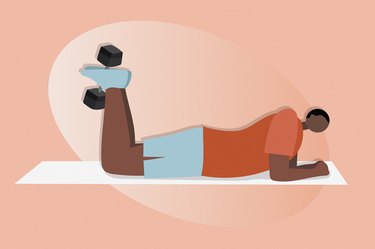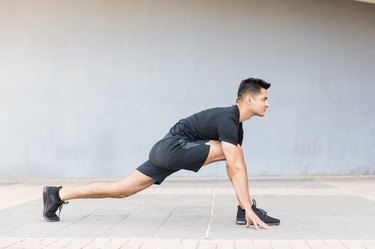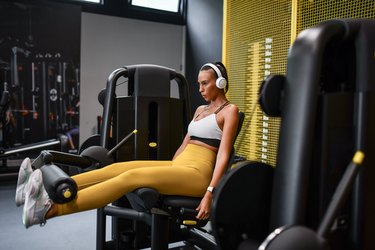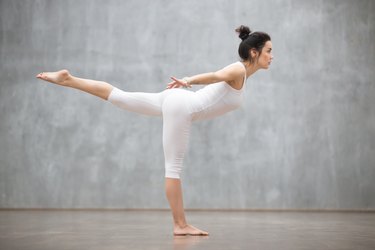
Just about every athlete and weekend warrior relies on strong hamstrings. These muscles are responsible for bending your knees. If they're strong, you can jump high, run fast and accelerate with explosive power. With well-developed hamstrings, you can maintain good posture and prevent leg injuries.
The hamstrings consist of three main muscles that extend from your sit-bones to your knees: the biceps femoris, the semitendinosus and the semimembranosus.
Video of the Day
Video of the Day
Key Functions
Because your hamstrings cross the knee and hip joints, they bend your knees and draw your hips backwards. Your hamstrings contribute to functional motion, such as walking, and they help you to achieve speed, power and agility in many sports. When executing explosive movement, these muscles play an important part in shifting the load from your knees to your hips. For example, a sprinter's ability to launch off the blocks and accumulate speed depends on strong hamstrings.
They also contribute to your ability to absorb the shock of movements involving high velocity or force.
Deceleration
During the course of a contraction, your hamstrings shorten and lengthen. The concentric, or shortening, phase of a muscular action allows you to bend your knee, the eccentric phase, or lengthening, of the muscle helps you to control the deceleration of your body.
For example, when you're running downhill, the lengthening of your hamstrings helps you to control the speed of the descent. This ability to properly decelerate lowers the amount of pressure on the joints in your lower body and prevents injury.
Posture and Alignment
Strong hamstrings work to stabilize your hips and keep your spine properly aligned. Envision your skeletal system as a connected chain; if one link moves out of alignment, problems ripple through the chain.
If your hamstrings are weak and tight, they'll tug on your hips -- tipping them forward -- and compromise functional movement. A swayback posture, in which your lower back arches and shoulders round, may result.
Your hamstrings also keep your knee and surrounding connective tissue in alignment.
- Nordic Walking for Total Fitness; Suzanne Nottingham, Alexandra Jurasin
- Bodyweight Strength Training Anatomy; Bret Contreras
- Triathlon Anatomy; Mark Klion, Troy Jacobson
- The Encyclopedia of Women’s Health; Christine Ammer
- Run Strong; Kevin Beck
- T Nation: The 7 Best “Regular” Hamstring Exercises
- Boot Camp Fitness Guide: Hamstring Exercises
- Aurora Health Care: Perfect Posture: Stronger Hamstrings Reduce Harmful Stress



